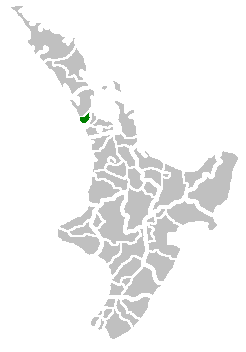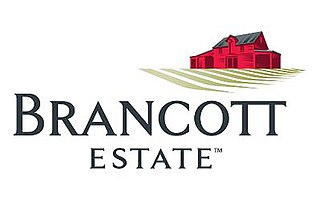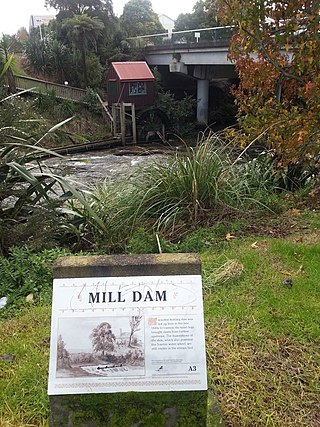
Waitakere City was a territorial authority in West Auckland, New Zealand; it was governed by the Waitakere City Council from 1989 to 2010. It was New Zealand's fifth-largest city, with an annual growth of about 2%. In 2010 the council was amalgamated with the other authorities of the Auckland Region to form the current Auckland Council.

Henderson is a suburb of Auckland, New Zealand. It is 13 kilometres (8.1 mi) west of Auckland city centre, and two kilometres (1.2 mi) west of the Whau River, a southwestern arm of the Waitematā Harbour.

Kumeū is a town in the Auckland Region, situated 25 kilometres (16 mi) north-west of the City Centre in New Zealand. State Highway 16 and the North Auckland Line pass through the town. Huapai lies to the west, Riverhead to the north, Whenuapai to the east, and Taupaki to the south.

Corbans Wines was one of New Zealand's oldest wineries, established in 1902 by Assid Abraham Corban, a Lebanese immigrant who had arrived in New Zealand ten years earlier. Corbans Wines grew to become the second largest producer of wine in New Zealand, until they were purchased by their largest competitor Montana Wines in 2000. Following several takeovers of Montana by Allied Domecq and then Pernod Ricard, the Corbans brand was spun off in 2011 and is now owned by Lion.

New Zealand wine is produced in several of its distinct winegrowing regions. As an island country in the South Pacific Ocean, New Zealand has a largely maritime climate, although its elongated geography produces considerable regional variation from north to south. Like many other New World wines, New Zealand wine is usually produced and labelled as single varietal wines, or if blended, winemakers list the varietal components on the label. New Zealand is best known for its Marlborough Sauvignon Blanc, and more recently its dense, concentrated Pinot Noir from Marlborough, Martinborough and Central Otago.

Washington wine is a wine produced from grape varieties grown in the U.S. state of Washington. Washington ranks second in the United States in the production of wine. By 2017, the state had over 55,000 acres (220 km2) of vineyards, a harvest of 229,000 short tons (208,000 t) of grapes, and exports going to over 40 countries around the world from the 940+ wineries located in the state. While there are some viticultural activities in the cooler, wetter western half of the state, the majority (99.9%) of wine grape production takes place in the shrub-steppe eastern half. The rain shadow of the Cascade Range leaves the Columbia River Basin with around 8 inches (200 mm) of annual rain fall, making irrigation and water rights of paramount interest to the Washington wine industry. Viticulture in the state is also influenced by long sunlight hours and consistent temperatures.

Brancott Estate is the brand adopted since 2010 by Pernod Ricard for New Zealand's largest wine producer, formerly Montana Wines, which now operates as the New Zealand division of Pernod Ricard Winemakers. The name comes from its Brancott winery in Blenheim, and was chosen to reduce confusion in the United States market with wines from the state of Montana.

The production of wine in New Jersey has increased significantly in the last thirty years with the opening of new wineries. Beginning in 1981, the state legislature relaxed Prohibition-era restrictions and crafted new laws to facilitate the growth of the industry and provide new opportunities for winery licenses. Today, New Jersey wineries are crafting wines that have earned recognition for their quality from critics, industry leaders, and in national and international competitions. As of 2019, New Jersey currently has 51 licensed and operating wineries with several more prospective wineries in various stages of development.

Don Buck was a Portuguese immigrant in New Zealand in the late nineteenth and early twentieth century. He was known for working newly released prisoners as gum diggers and trading the gum for a profit.
Assid Khaleel Corban was a New Zealand local-body politician and company director. He was the first Mayor of Waitakere City and previously Mayor of the Henderson Borough Council.

Henry Walker Crabb, also known as H. W. Crabb, Hiram Walker Crabb or Hamilton Walker Crabb, was an American wine cultivator, considered one of the pioneers of the development of the Napa Valley as a wine region. In the 1880s, his vine collection was one of the largest in the world.

Waikumete Cemetery, originally Waikomiti Cemetery, is New Zealand's largest cemetery. It occupies a site of 108 hectares in Glen Eden, Auckland, and also contains a crematorium in the south-west corner of the cemetery.
Lebanese New Zealanders refers to citizens or permanent residents of New Zealand of Lebanese ancestry. The community is diverse, having a large Christian religious base, being mostly Maronite Catholics and Greek Orthodox, while also having a small Muslim group of both the Shia and Sunni branches of Islam.

The Hawke's Bay wine region is New Zealand's oldest and second-largest wine-production region, on the east coast of the North Island. Production reached 41,000 tonnes in 2018 from 4,681 hectares of planted vines, representing 10.2% of total national production. Some of the oldest wineries still operating in New Zealand, including Te Mata Estate, Church Road, and Mission Estate, were established in the Hawke's Bay area in the late 19th century. Despite this, it was only established as a geographical indication (GI) in 2018. The GI protects any wine produced within the boundaries of the entire Hawke's Bay Region, but in practice the vineyards are chiefly concentrated in the plains and low hills surrounding the cities of Napier and Hastings.

Mission Estate Winery is New Zealand's oldest surviving winemaking concern, first established in the Hawke's Bay in 1851 by French Catholic Marist missionaries for producing sacramental wine. It is one of the largest wineries in the Hawke's Bay and remains wholly New Zealand owned.
The 1999 Queen's Birthday Honours in New Zealand, celebrating the official birthday of Queen Elizabeth II, were appointments made by the Queen in her right as Queen of New Zealand, on the advice of the New Zealand government, to various orders and honours to reward and highlight good works by New Zealanders. They were announced on 7 June 1999.

Corban Estate Arts Centre is an arts precinct in West Auckland, New Zealand. Established in 2002 at the site of the Mt Lebanon Vineyard and Winery, the arts centre provides creative production, theatre and gallery space to New Zealand artists.

West Auckland is one of the major geographical areas of Auckland, the largest city in New Zealand. Much of the area is dominated by the Waitākere Ranges, the eastern slopes of the Miocene era Waitākere volcano which was upraised from the ocean floor, and now one of the largest regional parks in New Zealand. The metropolitan area of West Auckland developed between the Waitākere Ranges to the west and the upper reaches of the Waitematā Harbour to the east. It covers areas such as Glen Eden, Henderson, Massey and New Lynn.

The Ōpanuku Stream, formerly known as the Henderson Stream, is a stream of the Auckland Region of New Zealand's North Island. It flows east from its source the Waitākere Ranges through the Henderson Valley, then north-east through West Auckland before entering into the Te Wai-o-Pareira / Henderson Creek, which flows into the western the Waitematā Harbour. The stream passes through the rural locality of Henderson Valley and the West Auckland suburbs of Western Heights and Henderson. Since the mid-2000s it has been forested with native flora.


















